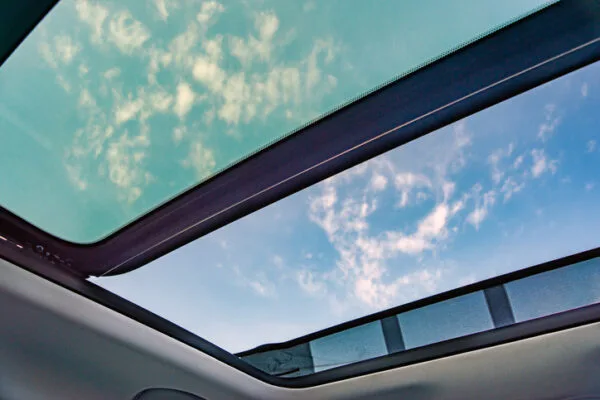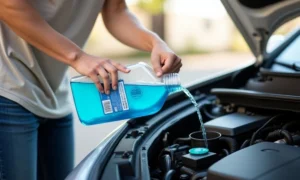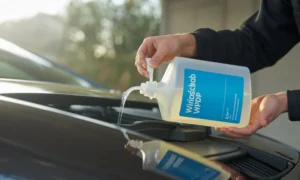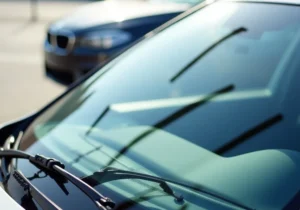How Much Is Car Window Tinting How much is car window tinting? Car window tinting...
How to Fix A Leaky Sunroof
Sunroofs are a popular feature in many vehicles, providing a refreshing and open-air driving experience. However, they are not without their issues, and one common concern is that how to fix a leaky sunroof. These leaks can stem from various sources, such as deteriorating seals, clogged drainage channels, or damaged components. Addressing these issues promptly is crucial to maintaining the overall integrity of your vehicle. In this regard, understanding how to fix a leaky sunroof is essential for preventing further damage and ensuring a comfortable and dry driving environment.
Understanding The Sunroof Leaking Problem
Finding the Source of the Leak
Checking the Sunroof Seal:
- Look closely at the seal for any cracks, tears, or signs of wear.
- Make sure the seal is in the right position and properly fitted.
- Remove any dirt or objects that might be preventing a tight seal.
Checking for Drainage Blockages:
- Inspect the drainage channels around the sunroof for clogs.
- Clear out leaves, dirt, or debris that might be blocking water flow.
- Use compressed air or water to flush the drainage tubes and keep them clear.
Inspecting the Sunroof Frame and Glass:
- Check the frame for any damage, rust, or corrosion that could affect sealing.
- Look for cracks or chips in the glass that might let water in.
- Ensure the sunroof glass is properly aligned to prevent leaks.
How to Fix a Leaky Sunroof Seal

Materials Needed:
- Mild soap or detergent
- Soft brush or toothbrush
- Clean, lint-free cloth
- Rubber conditioner or protectant
Steps:
Open the Sunroof
- Fully open the sunroof to access the seal.
Clean the Seal
- Mix mild soap with water.
- Dip a soft brush or toothbrush into the soapy water.
- Gently scrub the seal to remove dirt and debris, paying close attention to the edges and corners.
Rinse and Dry
- Use clean water to rinse off any soap.
- Wipe the seal with a clean cloth and let it air dry completely.
Apply Rubber Conditioner
- Once the seal is dry, apply a rubber conditioner or protectant.
- Follow the product instructions for the best results.
Fixing Minor Cracks or Gaps in the Seal
Materials Needed:
- Clear silicone sealant
- Caulk gun
- Clean cloth
Steps:
Find the Damage
- Inspect the sunroof seal for any cracks or gaps.
Clean the Area
- Wipe the damaged spot with a clean cloth to remove dirt and debris.
Apply Silicone Sealant
- Load the sealant into the caulk gun.
- Apply a thin, even layer along the cracks or gaps.
- Smooth the sealant with a clean finger or tool to ensure good adhesion.
Let it Cure
- Allow the sealant to dry according to the manufacturer’s instructions.
Replacing a Damaged Sunroof Seal
Materials Needed:
- Replacement sunroof seal
- Screwdriver or trim removal tool
Steps:
Get the Right Seal
- Buy a sunroof seal that matches your vehicle’s specifications.
Open the Sunroof
- Fully open it to access the old seal.
Remove the Old Seal
- Use a screwdriver or trim removal tool to carefully pry off the old seal.
- Work around the sunroof, gently detaching the seal from its groove.
Clean the Area
- Wipe down the surface to remove any leftover debris.
Install the New Seal
- Press the new seal into place, ensuring it fits securely all around.
Close the Sunroof
- Close it to help the new seal settle properly.
Check for Leaks
- Pour water over the sunroof and check if any leaks remain.
Best Way to Fix a Leaky Sunroof

Fixing a leaky sunroof can be done using various methods, depending on the severity of the issue. Here are three approaches you can consider:
Using Specialized Sunroof Repair Kits:
- Purchase a sunroof repair kit from an automotive store or online. These kits typically include sealants and adhesives designed specifically for sunroof repair.
- Follow the instructions provided with the kit carefully. Clean the area around the sunroof thoroughly before applying any sealant.
- Apply the sealant or adhesive to the areas where leaks are occurring. Ensure a proper and even application for effective sealing.
Tips for Adjusting Sunroof Alignment:
- In some cases, leaks may be caused by misalignment of the sunroof. Inspect the sunroof to see if it is properly aligned.
- Consult your vehicle’s manual for guidance on adjusting the sunroof alignment. This may involve loosening and adjusting the mounting bolts.
- Make incremental adjustments, testing the sunroof for leaks after each adjustment. Ensure that the sunroof closes securely and aligns with the surrounding roof.
Common Household Items for Quick Fixes:
For temporary fixes, you can use household items to address minor leaks:
Weather Stripping: Apply weather stripping around the sunroof’s perimeter to provide an additional barrier against water.
Silicone Sealant: Use clear silicone sealant to seal small cracks or gaps around the sunroof. Ensure the surface is clean and dry before applying the sealant.
Duct Tape: In emergency situations, use duct tape to cover small leaks temporarily. However, this is not a permanent solution.
For sunroof repair in Austin, TX contact Texas Reliable Auto Glass.
Leaky Sunroof Repairing by Professionals
Professional repair services for leaky sunroofs typically involve skilled technicians who specialize in automotive glass and sunroof repairs. These professionals are equipped with the knowledge and tools necessary to identify and fix leaks efficiently. Here’s an overview of the key steps involved in professional sunroof repair:
Assessment: The first step is a thorough assessment of the sunroof to identify the source of the leak. This may involve inspecting seals, drainage channels, and the overall condition of the sunroof.
Cleaning and Preparation: Technicians often clean the sunroof and surrounding areas to ensure a proper seal during the repair process. Any debris or contaminants that could compromise the repair are removed.
Seal Replacement or Repair: The repair specialist may replace damaged seals or repair existing ones. This is crucial for preventing water from entering the vehicle.
Testing: After the repair, the sunroof is tested to ensure that the issue has been resolved. This may involve using water or other testing methods to verify the effectiveness of the repair.
Preventive Measures: Some professionals may recommend additional preventive measures, such as applying sealant or protective coatings to enhance the longevity of the repair.
Cost Considerations and Potential Benefits:
Cost Factors: The cost of professional sunroof repair can vary based on factors such as the extent of the damage, the type of vehicle, and the specific repair techniques used. Generally, costs may include labor, replacement parts, and any additional materials required.
Potential Benefits:
Expertise: Professional repair services bring expertise and experience to the task, ensuring a comprehensive and lasting solution. If you want professional services related to sunroof repair then Texas Reliable Autos is the best choice.
Warranty: Reputable repair specialists may offer warranties on their work, providing assurance to customers.
Time Efficiency: Professionals can often complete repairs more efficiently than DIY attempts, minimizing downtime for the vehicle.
Choosing a Reputable Sunroof Repair Specialist:
Research: Look for repair shops or specialists with a good reputation for sunroof repairs. Online reviews, recommendations from friends or family, and ratings from automotive organizations can be valuable resources.
Certifications and Training: Ensure that the repair specialist or shop is certified and has technicians trained in sunroof repairs. This indicates a commitment to quality and professionalism.
Warranty: Inquire about warranties offered for the repair work. A reputable specialist should stand behind their services with a reasonable warranty period.
Estimates: Obtain detailed cost estimates from multiple repair specialists to compare prices and services. Be wary of significantly low prices, as they may reflect subpar workmanship or the use of inferior materials.
Conclusion
Fixing a leaky sunroof requires a systematic approach to identify and address the underlying issues. First and foremost, it is essential to locate the source of the leak. This can be achieved by thoroughly inspecting the rubber seals around the sunroof, checking for any visible damage or wear. Feel free to contact us for services or any type of queries like how to fix a leaky sunroof.
FAQs
How Can I Identify The Source Of A Leak In My Sunroof?
Start by inspecting the rubber seals around the sunroof for visible damage. Check for clogged drainage channels, and examine the interior for water stains to pinpoint the leak source.
Can I Temporarily Fix A Leak With A Diy Solution?
Yes, you can use silicone sealant on damaged seals as a temporary fix. However, it’s advisable to replace damaged seals for a more lasting solution.
What Tools Do I Need To Fix A Leaky Sunroof?
Basic tools such as screwdrivers, compressed air, and a gentle cleaning tool for clearing drainage tubes. If replacing seals, you may need specific tools for removing and installing them.
How Do I Replace Sunroof Seals?
Carefully remove the old seals, clean the area, and install new, high-quality seals. Ensure a proper fit and consider consulting your vehicle’s manual for specific instructions.
Can Clogged Drainage Tubes Cause A Sunroof Leak?
Yes, debris in drainage channels can lead to leaks. Use compressed air or a cleaning tool to clear clogs, and regularly maintain the channels to prevent future issues.
Our Services
Our Latest Blogs
How Do You Unfreeze Windshield Wiper Fluid
How Do You Unfreeze Windshield Wiper Fluid How do you unfreeze windshield wiper fluid during...
How To Refill Windshield Wiper Fluid
How To Refill Windshield Wiper Fluid How to refill windshield wiper fluid is a simple...
What Kind Of Windshield Wipers Do I Need
What Kind Of Windshield Wipers Do I Need What kind of windshield wipers do I...





